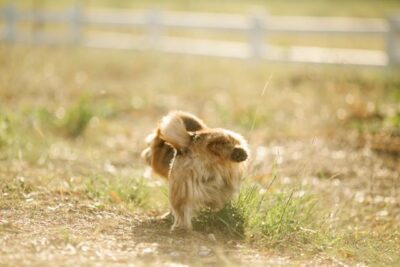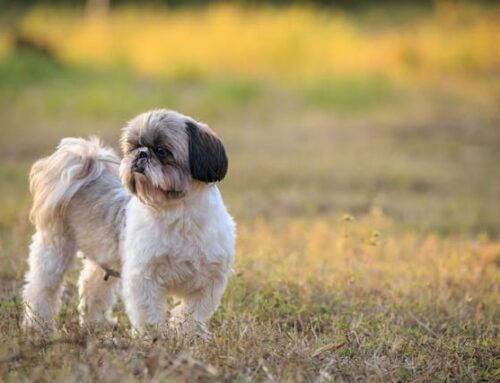Introduction: How to Toilet Train a Puppy in 7 Days
Is it possible to potty train a puppy in just seven days? It’s possible! By following the carefully outlined steps in our comprehensive guide on How to Toilet Train a Puppy in 7 Days, you can make it happen.
With unwavering determination, patience, and a commitment to the strategies detailed in this blog post, you can realize your dream of having a housebroken pup.
Before embarking on this journey, it’s crucial to prepare adequately and gain a deep understanding of the training process tailored to your individual dog. This knowledge will enable you to effectively implement strategies for achieving the goal of potty training within a mere seven days. Let’s embark on this exciting journey together!
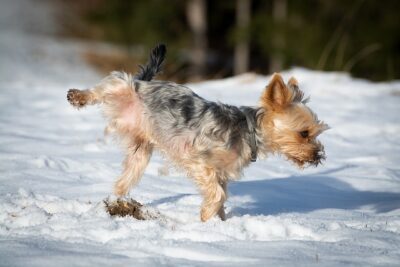
Key Takeaways: Potty Train A Puppy
- Achieve successful puppy potty training in just 7 days through proper preparation, comprehensive understanding, and unwavering commitment.
- Follow our meticulously crafted plan to establish a consistent routine, reinforce positive behaviors, and closely monitor your puppy’s progress.
- Celebrate each milestone along the way and savor the rewards of a well-trained pup, all while navigating through common challenges such as male dogs, dietary considerations, and leveraging your puppy’s natural instincts.
- Discover how your puppy learns, how to work with their keen sense of smell, the importance of crate training, and the significance of a structured feeding schedule in your potty training journey.
How to Toilet Train a Puppy in 7 Days
Potty training puppies is an important job that all dog owners should take on. Our step-by-step guide, How to Toilet Train a Puppy in 7 Days, will provide the knowledge and tools to successfully house-train a pup in seven days.
It’s essential to set realistic expectations before starting, as consistency with time management and rewards are key for your pup’s desired behavior, which ultimately leads to them being fully potty trained at about nine months of age – so don’t give up!
To make this challenge less daunting, we’ll start off understanding what young dogs need and then move onto our 7-day plan designed to help you breeze through common difficulties while still enjoying having such a well-trained companion. It won’t be easy but worth the effort put in at the end.
Learn How to Toilet Train a Puppy in 7 Days: A Guide to Successfully House Training Your Puppy
To prepare how to toilet train a puppy in 7 days, ensure you have the right tools, including a crate for confinement and a pet-safe disinfectant for cleaning. Set up a designated potty area outside and establish a consistent routine for feeding and bathroom breaks.
Supervise your puppy closely, rewarding them for going in the correct spot, and be patient as accidents are part of the learning process. With consistency and positive reinforcement, your puppy can be fully house trained in no time!
Understanding Your Young Puppy: Potty Train Puppies
Toilet training a puppy in 7 days can be successful when you start at the right time, usually between 8 and 16 weeks old, when they are beginning to develop bladder control. Paying attention to your puppy’s individual needs will make the process easier and more effective.
Watch for signs such as sniffing around, circling, or whining, which indicate it’s time for a potty break.
Understanding your puppy’s specific needs can help you tailor the training to them. By creating a personalized plan based on their traits and behaviors, you can set them up for success.
Every pup is unique, so recognizing their readiness is key to a successful training experience. Learn How To Toilet Train A Puppy in 7 Days by understanding your puppy’s needs and creating a personalized plan for them!
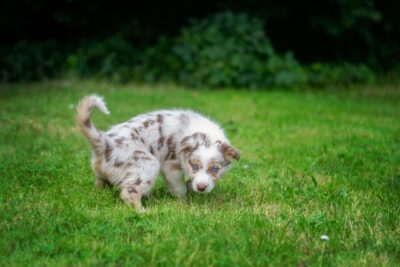
How to Toilet Train A Puppy in 7 Days Plan
Embarking on the journey of puppy potty training requires a methodical approach. This how to toilet train a puppy in 7 days plan is designed to instill successful toilet habits in your puppy within just a week.
It establishes a structured routine that reinforces positive behavior while allowing for adjustments as needed. Follow this guide to learn How to Toilet Train a Puppy in 7 Days.
Day 1: Setting the Stage for Success for House Training
To initiate potty training, create a designated outdoor area and gather all necessary supplies. Ensure that this potty spot is easily accessible to your puppy. Consistency in location helps your pup associate their needs with the designated area.
At this early stage of learning, it’s crucial to take your puppy out for potty breaks every 30-60 minutes. Allocate an additional 10-15 minutes for exploration and toileting. Cultivating good habits from the outset lays a strong foundation for a successful potty training journey ahead.
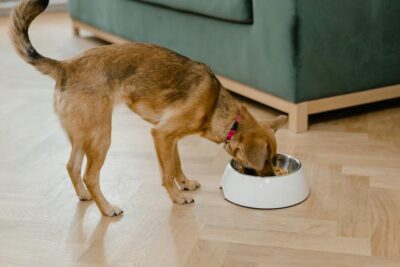
Day 2: Establishing a Consistent Puppy Potty Training Schedule
On the second day of your puppy’s potty training journey, it’s time to create a consistent daily routine that revolves around key activities like feeding, playtime, and regular potty breaks.
Here’s how to build an effective puppy potty training program:
1. Fixed Meal Times: Provide three small meals throughout the day, creating a consistent feeding schedule. This regularity helps you predict when your puppy will need to go potty.
2. Frequent Potty Breaks: Ensure your puppy takes bathroom breaks every 45 minutes while they’re awake. Supervise them closely during this period to prevent indoor accidents and guide their behavior correctly.
3. Gradual Adjustments: As your puppy adapts to this routine, you can gradually increase the time between outdoor toilet breaks. Make adjustments based on specific variables like your puppy’s age and bladder control. The key is to find a balance that leads to successful results while staying within the established parameters.

Day 3: Crate Training Basics
On the third day of how to potty train your puppy, it’s time to introduce crate training, a valuable tool for cultivating proper toilet behavior.
Here’s how to get started:
1. The Purpose of Crate Training: Crates provide a safe space for puppies where they cannot soil. This encourages them to learn to “hold it” when necessary, promoting good potty habits.
2. Creating a Comfortable Crate: Make your pup’s crate inviting by adding comforting elements like blankets, rugs, or engaging Kong toys. These items create a positive association with the crate and can be great rewards when placed inside with some treats.
3. Mealtime in the Crate: Feed your puppy within the crate to further enhance their positive association with it. This not only provides an enjoyable experience but also reinforces good habits simultaneously.
4. Use of Puppy Pads: During this phase, consider placing puppy pads in your pup’s living space to maintain cleanliness. Puppy pads can help manage accidents and keep the area tidy.
Day 4: Gradual Outdoor Introduction
As you embark on day four of how to potty train your puppy, it’s time to introduce them to the great outdoors gradually.
This step is crucial in helping your puppy associate outdoor spaces with potty time. Here’s how to make the most of this day:
- Short Outdoor Visits: Start by taking your puppy outside for short visits, preferably on a leash. Limit these initial outings to no more than 5 minutes during each potty break. The goal is to keep the outdoor experience brief and focused on potty activities.
- Gradually Increase Duration: Over time, gradually extend the duration of these outdoor excursions. As your puppy becomes more accustomed to the outdoor environment and gains confidence in relieving themselves outdoors, you can increase the time spent outside. This progressive approach helps reinforce the positive progress you’ve made so far in the training process.
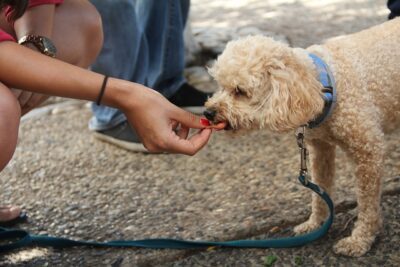
Day 5: Reinforcing Positive Behavior
As you progress into day five of how to potty train your puppy, it’s time to reinforce positive behavior with rewards and encouragement.
This step is crucial for building a strong association between the correct action and its desired outcome, which is successful potty training. Here’s how to go about it:
- Reward Correct Behavior: Whenever your puppy goes potty in the designated area, be sure to reward them. Offer a small treat as an immediate reward for their good behavior. This positive reinforcement serves as a powerful motivator for your puppy to repeat the desired action.
- Praise and Encouragement: Along with treats, shower your puppy with plenty of praise and encouragement. Use a cheerful and positive tone of voice to let them know they’ve done a great job. Petting and offering affection can further reinforce their understanding of what pleases you.
- Consistency is Key: Consistency in rewarding correct behavior is essential. Ensure that every time your puppy successfully uses the assigned area for potty, they receive both treats and praise. This consistent approach reinforces the connection between their actions and positive outcomes.

Day 6: Monitoring Progress and Adjusting the Routine
As you approach the sixth day of how to potty train your puppy, it’s time to evaluate their progress and be prepared to make necessary adjustments to the routine.
Here’s how you can effectively monitor your puppy’s progress and adapt as needed:
- Observing Your Puppy: Spend time closely observing your puppy’s behavior during their potty breaks. Look for signs that they are beginning to comprehend what is expected of them. These signs may include sniffing around the designated potty area, circling, or showing restlessness.
- Reinforce Proper Behavior: If you notice any deviations from the desired behavior, such as attempting to potty indoors, gently redirect your puppy to the designated potty area. Reward them with treats and praise when they do the right thing. Consistently reinforcing proper behavior helps solidify the house training.
- Addressing Challenges: Be prepared to address any challenges or setbacks that may arise during this process. Some puppies may take longer to fully grasp the concept of potty training, and that’s okay. Patience and persistence are key. If you encounter difficulties, consider seeking advice from a professional dog trainer or behaviorist.
- Adapting the Routine: Based on your observations and your puppy’s progress, be willing to adapt the routine as needed. This may involve adjusting the timing of potty breaks, extending the duration between breaks, or fine-tuning other aspects of the training process to better suit your puppy’s learning style.
Day 7: Building Independence and Confidence
As you approach the final day of how to potty train your puppy, your focus should be on nurturing your pup’s independence and confidence. By this stage, they should be well-acquainted with the potty training routine and capable of taking toilet breaks independently.
Here’s how you can encourage their growth and success:
- Promote Independence: Begin by allowing your puppy some freedom around the house while maintaining close supervision. This step is crucial in helping them realize that going outdoors is the appropriate choice for relieving themselves. It’s essential to strike a balance between providing guidance and permitting growing autonomy.
- Supervision: While granting your puppy more freedom, maintain vigilant supervision. Keep an eye on their behavior and be ready to intervene if they show signs of needing a potty break. This proactive approach helps prevent accidents indoors and reinforces the outdoor potty habit.
- Managing Too Much Freedom: While granting more freedom is crucial for fostering independence, it’s equally important to be mindful of “too much freedom.” This means ensuring your puppy doesn’t have unrestricted access to areas where accidents could happen. Utilize baby gates or designate a safe play area to manage their movements effectively.
- Lodging Your Puppy: Ensure you are familiar with how to correctly house your puppy during this transitional phase. Consider using a safe and secure space within your home, such as a designated playpen or puppy-proofed room, where they can move freely but still be contained if needed.
- Positive Reinforcement: Continue to use positive reinforcement, praise, and treats when your puppy chooses to go potty outdoors. Reinforce the idea that this behavior is highly desirable and rewarding.
- Ongoing Success: The goal of this final day is to set the stage for ongoing success in your puppy’s toileting habits. By allowing them to exercise their independence and confidently make the right choices, you’re reinforcing the lessons learned throughout the training process.
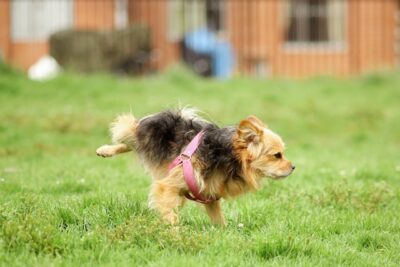
How To Toilet Train A Puppy in 7 Days: Common Challenges and Solutions
When it comes to effective puppy potty training, there may be certain obstacles that arise during the housebreaking process. The goal is to identify these challenges and create strategies in order for your pup’s success with potty training.
Here are some common difficulties found while doing this type of potty training along with solutions to help overcome them.
Accidents Happen: How to Handle Them
It is unavoidable that your pup will have some mess-ups during potty training, and it’s important to act accordingly. Whenever an accident happens indoors, approach the situation calmly but sternly and take them directly to their designated toilet area even if they appear finished with their business.
To maintain a clean household environment it is necessary for you to thoroughly remove traces of accidents by using non-toxic solutions such as Nature’s Miracle which contain enzymes making sure this won’t turn into a recurring event at the same spot. Lastly, use any slip-up not just for cleaning purposes but also to keep teaching positive behaviors throughout potty training!
Dealing with Stubborn Puppies
Potty training can be a challenge, especially when dealing with stubborn puppies. However, there are effective strategies to overcome this hurdle. Utilizing positive reinforcement techniques with treats and ensuring your puppy gets plenty of physical exercise and mental stimulation can help address their stubbornness.
To tackle issues like bad habits and establish successful potty training routines, consider these steps:
- Positive Reinforcement: Reward your puppy with treats when they exhibit good behavior during potty training. This can encourage them to adopt desirable habits.
- Balanced Diet: Pay attention to your puppy’s food bowl and provide a balanced diet. A healthy puppy is more likely to have good potty habits.
- Understanding Preferences: Learn what your puppy likes and dislikes. This knowledge can help tailor your training approach to their preferences.
- Scent Recognition: Understanding your puppy’s nose plays a significant role in their behavior. Use scents strategically to guide them to the right potty spot for breaks.
- Comfortable Environment: Ensure your puppy’s living space is comfortable and meets their needs. A cozy environment can contribute to successful potty training.
- Motivation: Puppies are highly motivated by rewards and positive interactions. Leverage this motivation to reinforce good habits.
- Most Dogs Can Learn: Remember that most dogs can learn proper potty habits with the right training and consistency.
- Crate Train: Consider crate training as a useful tool to aid in potty training. A crate can provide a secure space for your puppy and help with routine.
- Vet Visits: Regular veterinary visits are crucial for your puppy’s overall health. Discuss any concerns about their potty training progress with your vet.
Addressing Regression
Potty training regressions can be very discouraging, but it’s essential to stay patient and consistent. If you observe a downturn in your puppy’s potty progress, try repeating earlier steps while rewarding them for correct behavior before going any Forward.
If the situation continues or there appears to be an underlying medical problem behind these issues, don’t hesitate to ask for advice from trained professionals such as vets, trainers, and/or animal behaviorists.
Conclusion: How To Toilet Train A Puppy in 7 Days
Toilet training a puppy in 7 days is achievable with dedication and the right techniques. By following a structured plan, understanding your puppy’s needs, and addressing challenges as they arise, you can successfully train your puppy to be housebroken.
Remember to be patient, consistent, and celebrate each milestone along the way. Learn How To Toilet Train A Puppy in 7 Days and enjoy the rewards of having a well-trained and obedient companion!
Summary: How To Toilet Train A Puppy in 7 Days
Toilet training a puppy in 7 days is possible with the right approach. The key is to prepare adequately, understand your puppy’s needs, and commit to a structured training plan. By setting up a consistent routine, using positive reinforcement, and gradually introducing your puppy to outdoor potty areas, you can achieve success.
Common challenges such as accidents and stubbornness can be overcome with patience and the right strategies. Celebrate each milestone and enjoy the rewards of a well-trained pup. Learn How To Toilet Train A Puppy in 7 Days with these effective tips!
Frequently Asked Questions: How To Toilet Train A Puppy in 7 Days
Q1: What is the key to effective potty training?
- A1: Effective puppy potty training involves consistency, positive reinforcement, and understanding your puppy’s needs. It’s about teaching them where and when to go potty.
Q2: Can I really toilet-train my puppy in just 7 days?
- A2: While it’s possible to make significant progress in 7 days, full mastery may take longer. The goal is to establish good habits and a strong foundation in this time.
Q3: What’s the role of crate training in potty training?
- A3: Crate training helps regulate a puppy’s access to the house and encourages them to hold it until you take them to the designated potty area. It’s a valuable tool in the process.
Q4: How often should I take my puppy out for potty breaks?
- A4: On the first day, every 1-2 hours is recommended. As your puppy progresses, you can gradually extend the time between breaks.
Q5: What if my puppy has a few accidents indoors?
- A5: Accidents are common, especially with young puppies. Clean the soiled area thoroughly to remove the scent, and remain patient and consistent with your training.
Q6: What is the significance of a designated potty area?
- A6: A designated potty area helps your puppy understand where it’s appropriate to go. Consistently using the same place reinforces the behavior.
Q7: Is positive reinforcement important in potty training?
- A7: Yes, positive reinforcement, such as treats and praise, is essential. It helps your puppy associate going potty in the right place with rewards.
Q8: Can I use wee wee pads or a litter box for indoor potty training?
- A8: Yes, especially if you live in an apartment or have limited outdoor access. You can gradually transition your puppy from these options to outdoor potty breaks.
Q9: What’s the role of a fixed meal schedule in potty training?
- A9: A fixed meal schedule helps you predict when your puppy will need to go potty, making it easier to plan potty breaks.
Q10: How can baby gates be helpful in potty training?
- A10: Baby gates are useful for creating boundaries and controlling your puppy’s access to certain areas of your home. They can help confine your puppy to a designated potty training area or prevent them from entering rooms where accidents might occur.
Q11: How do I recognize signs that my puppy needs to go potty?
- A11: Watch for signs like sniffing, circling, whining, or sudden restlessness. These cues indicate your puppy needs a potty break.
Q12: How long should I keep my puppy in the crate during crate time?
- A12: The duration of crate time depends on your puppy’s age and bladder control. Younger puppies may need shorter intervals, while older ones can stay longer.
Q13: Is crate training suitable for all puppies? What if my puppy doesn’t like the crate?
- A13: Introduce the crate gradually and make it a comfortable space. Use positive reinforcement to create a positive association with the crate. Crate training can be effective for most puppies, but it’s essential to adapt the training approach to your puppy’s personality and needs.
Q14: How do I prevent my puppy from going potty in the wrong place?
- A14: Supervise your puppy closely, use a leash indoors, and be consistent with potty breaks and positive reinforcement.
Q15: What should I do if my puppy has occasional accidents even after training?
- A15: Continue with positive reinforcement and supervision. Occasional accidents are normal, but consistency will lead to improvement.
Q16: Can I use a verbal cue to signal when it’s potty time for my puppy?
- A16: Yes, using a verbal cue like “go potty” helps your puppy associate the action with the command, making communication easier.
Q17: How can I understand my puppy’s body language during potty training?
- A17: Pay attention to cues like sniffing, circling, or whining, which may indicate your puppy needs to go potty.
Q18: What if my puppy doesn’t like going potty outdoors?
- A18: Be patient and consistent with outdoor potty breaks, and continue using positive reinforcement to encourage the desired behavior.
Q19: What is paper training for puppies?
- A19: Paper training is a method of potty training for puppies that involves teaching them to relieve themselves on newspaper or absorbent pads placed in a designated area indoors.
Q20: How often should I refill my puppy’s water dish?
- A20: Provide access to water throughout the day, but monitor their intake to avoid excessive drinking before bedtime.
Q21: How to toilet train a puppy in 7 days?
- A21: How to toilet train a puppy in 7 days requires consistency, patience, and a structured routine. Start by taking your puppy outside frequently, especially after meals and naps, and praise them when they eliminate outdoors. Use a crate or confine them to a small area when indoors and supervise them closely. Clean up accidents with an enzymatic cleaner to remove the scent. Gradually increase the time between bathroom breaks as your puppy learns.

